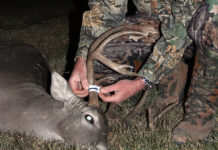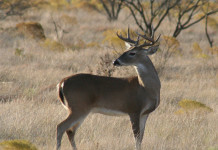It’s hard to get biologists and land managers to utter words such as “extraordinary,” “outstanding” or “spectacular” when discussing the Texas deer outlook.
However, those terms certainly are applicable this fall and winter, and in the minds of some deer experts, the forecast has never been better. Here’s what you can expect as you pursue trophy whitetails and mule deer in 2016.
White-Tailed Deer Forecast
Alan Cain, the whitetail program leader for the Texas Parks & Wildlife Department, is the authority on deer hunting in the state and in his years in the position, he has never seen a fall and winter more primed for big bucks. And that’s not just in one or two regular hot spots but statewide, which is saying something.
“It’s has been quite a while since I remember a time when we’ve experienced great back to back years of good rains across most if not all of the state. Because Texas is such a large state, we don’t always see a good habitat conditions that stretch from Amarillo to Brownsville or El Paso to Houston, but 2016 has been an unusual year that the vast majority of the state has received good rains and surprisingly, temperatures have remained relatively mild,” Cain said. “This weather pattern bodes well for white-tailed deer, and the 2016 deer season is expected to be another excellent year.”
Two excellent years of moisture bevy his predictions of big things this fall, Cain noted.
“The foundation for a great deer season starts with the native habitat that supplies the nutritional resources deer need to maintain excellent body condition, does need to raise their fawns, and bucks need to maximize antler growth,” he said. “Consistent and timely rains as well as cooler temperatures this year have created a smorgasbord of lush green forbs and woody browse plants which comprise the majority of a deer’s diet. As such, deer should be in top body condition this year and antler quality should be above-average.”
Even in “average” years Texas remains tops in the country for whitetail hunting as a whole so going above and beyond that usual prognostication again is saying something.
One downside to the massive rainfall is the subsequent flooding of low-lying areas known to harbor good numbers of deer.
“Those river-bottom habitats along portions of major river drainages (Brazos, Trinity, Sabine, Colorado) in the eastern portion that are still inundated with floodwaters will not likely recover soon enough to benefit deer from a nutritional perspective, but those deer displaced by floodwaters and forced into upland habitat will not have to search far to find plenty of high-quality forage,” Cain noted.
In looking from north to south and east to west, Cain said the center of the state will remain the hotbed in quantity and, in many locales, quality.
“The Edwards Plateau, commonly referred to as the Texas Hill Country, supports the highest deer population in the state with a 2015 estimate of 117 deer per 1,000 acres, and 2016 numbers are expected to be a bit higher than last year resulting from higher fawn crops,” Cain said. “Hunters play a key role in habitat management by removing deer from the range through harvest and despite the excellent range conditions in the Hill Country this year, deer populations left unchecked can do serious damage to the native habitat that supports all wildlife therefore it is imperative for hunters to harvest as many deer as the bag limit allows.”
Good fawn crops in recent years will translate to good antlers in many notable areas, Cain noted.
“Looking back several years ago at previous fawn crops and projecting those numbers to the 2016 season, hunters should expect to see a good number of 2.5-, 3.5-, 4.5-, and 6.5-year-old bucks relative to other age groups for the Edwards Plateau and Cross Timbers region. That’s not to say there’s still not a good number of mature bucks in the population. In fact, 2016 should be an excellent year for bucks in that 4.5- to 6.5-year-old age group as a whole relative to the last several years for these regions of the state.”
Two other hot spots this fall for big deer will be the Rolling Plains as a whole and, of course, South Texas.
“The projected number of bucks in the 4.5- and 7.5-year-old age class will be higher relative to other age groups in the western Rolling Plains and in the Eastern Rolling Plains the buck age structure will be more similar to that of the Cross Timbers with more bucks in the 3.5-, 4.5-, and 6.5-year-old age groups,” Cain said. “The South Texas Plains region is known for exceptional bucks produced in that region and a moderate deer density compared to other areas of the state. South Texas has been plagued by dry conditions over the last six to eight years so the fawn crops have been relatively low but consistent which translate into a relatively even distribution of bucks among all age classes. So hunters should expect to see a good number of bucks in the 4.5- to 7.5-year-old age class. With the expectation of above-average antler quality, the opportunity to bag a good quality older-age class buck should be within reach of many hunters in South Texas.”
In looking at the big-buck forecast in the Pineywoods of East Texas and the Post Oak Savannah to the southwest area adjacent, Cain noted flooding will play a significant factor.
“The extensive flooding occurring this spring in the Pineywoods will likely have some impact on the deer population in the region and I would expect the overall numbers to be down a little this year,” Cain said. “Hunters should be cognizant that as flooding occurs, deer will be temporarily displaced from their normal ranges resulting in dramatic population increase in localized areas adjacent to the river drainages and floodplains that typically have much higher deer densities than these upland sites. One benefit is that those wise old bucks that have avoided hunters for years in those dense river-bottom thickets may be more visible and present a greater opportunity to harvest one of these trophies. Hunters should enjoy these opportunities but be mindful not to over harvest the deer population that resulted from a temporary increase due to flooding.
“Based on previous year fawn crops, Post Oak Savannah hunters should expect to see more 3.5-, 6.5-, and 8.5-year-old bucks relative to other age classes. There is a fairly even distribution of bucks among the other age classes. Antler-restriction regulations (in the Post Oak and Pineywoods) continue to improve the buck age structure in these regions and is reflected in the annual harvest where age and antler surveys conducted by TPWD wildlife biologist indicate 53 percent of bucks are 3.5 years of age or older in the Post Oak Savannah and 64 percent in the Pineywoods. Despite having some of the highest hunter densities in the state, these regions continue to produce good quality deer.”
With antler quality projected to be excellent this season, Cain noted that the hot spots that are notable for obvious reasons will continue to produce big deer. However, it’s a great time to be a deer hunter in Texas in general.
“Although South Texas is a destination location for hunters looking for a true giant in the antler department, I wouldn’t discount any region of the state,” Cain said. “Statewide last season, the average Boone & Crockett score for bucks 6.5 years old or older was 129.92 and for the 4.5-5.5 age group the average was 121.72 B&C … very respectable quality bucks for anywhere in the state. Hunters looking for those trophy quality animals might focus their efforts in the Rolling Plains regions as well as South Texas.”
Texas deer hunting forecast: Changes bring more chances to fill tags
Mule Deer Forecast
Calvin Richardson, TPWD’s wildlife district leader for the Rolling Plains and High Plains ecoregions, again is expecting a good outlook when it comes to hunting the top of Texas and into western areas of the state.
When looking at a new season in advance, it’s important for deer to be in good shape during the time their antlers drop, Richardson said. It’s also good to look back at previous seasons to look for trends, which this fall and winter will include good moisture levels the past couple of years after lingering dry spells from 2011, 2012 and 2013. Those years were somewhat detrimental to fawn production for all deer species, but there should still be plenty of bucks, including mature ones, across much of the area he oversees.
“Most portions of the Rolling Plains received above-average rainfall this spring (15 inches to 20 inches), resulting in abundant cover and forage,” Richardson said. “Conditions are almost as good as you get for expecting a bumper crop of fawns. To the west, on the High Plains, rainfall came a little later in the spring. In general, the High Plains has seen less rainfall and as usual, thunderstorms are hit and miss across that country that stretches from the Oklahoma Panhandle almost down to Midland-Odessa.”
As a result of that moisture, and lack thereof in some areas, the forecast may not be as optimistic in some other seasons. However, even being on par with relatively average years is typically really good in our state.
“Forage conditions can be categorized as average going into the summer months,” Richardson noted. “There are more mule deer than white-tailed deer on the High Plains. The muleys tend to perform well even in dry times, especially given the intermittent buffet of wheat, corn, sorghum, alfalfa, and vegetables they may access on a seasonal basis.”
When it comes to horns, many hunters should see the benefits of spring rains on both muleys and whitetails. In lightly hunted areas, there’s a potential for older deer (6- and 7-year-olds) from a “decent” fawn crop in 2009-10, Richardson noted.
“Antler growth got off to an excellent start and if we got a few more showers in June and July, those will help bucks finish off a good antler production year,” Richardson said. “One possible downside is that we anticipate a reduced number of mature bucks in the herd as a result of poor fawn survival during 2011-13 (historic drought conditions). As always, this country will produce some Boone & Crockett mule deer and whitetails, but mature buck numbers may be affected by the low fawn crops during 2011-13 (reduced number of 4.5- and 5.5-year-olds).”
Richardson said TPWD will remain vigilant in the fight of chronic wasting disease, noting that the Hartley County discovery of the disease in a free-ranging muley will make check stations all the more important this fall and winter. Texas deer hunters as always are urged to properly dispose of carcasses from deer they shoot and safe handling recommendations include avoiding cutting through bones, spine or brain when processing deer. It should be noted that safe parts to transport include quarters or other portions of meat with no part of the spine or head attached; hides or capes from which all excess tissue has been removed; and antlers, including antlers attached to skull plates or skulls cleaned of muscle and brain tissue. Also, for taxidermy work, use a licensed taxidermist to ensure proper carcass disposal.
Eleven-year average estimated gross Boone & Crockett scores by ecoregion based on TPWD age and antler survey data collected each whitetail hunting season (2005-2015).
| Ecological Region | 2.5-3.5 Age Group | 4.5-5.5 Age Group | 6.5+ Age Group |
| Cross Timbers | 105 2/8 | 122 7/8 | 127 6/8 |
| Eastern Rolling Plains | 107 4/8 | 125 6/8 | 133 3/8 |
| Edwards Plateau | 93 2/8 | 113 4/8 | 119 5/8 |
| Pineywoods | 104 6/8 | 124 4/8 | 123 0/8 |
| Post Oak Savannah | 104 7/8 | 121 6/8 | 123 2/8 |
| South Texas Plains | 103 5/8 | 129 0/8 | 136 1/8 |
| Western Rolling Plains | 106 1/8 | 125 5/8 | 134 1/8 |
| Statewide | 102 6/8 | 121 4/8 | 128 0/8 |





















